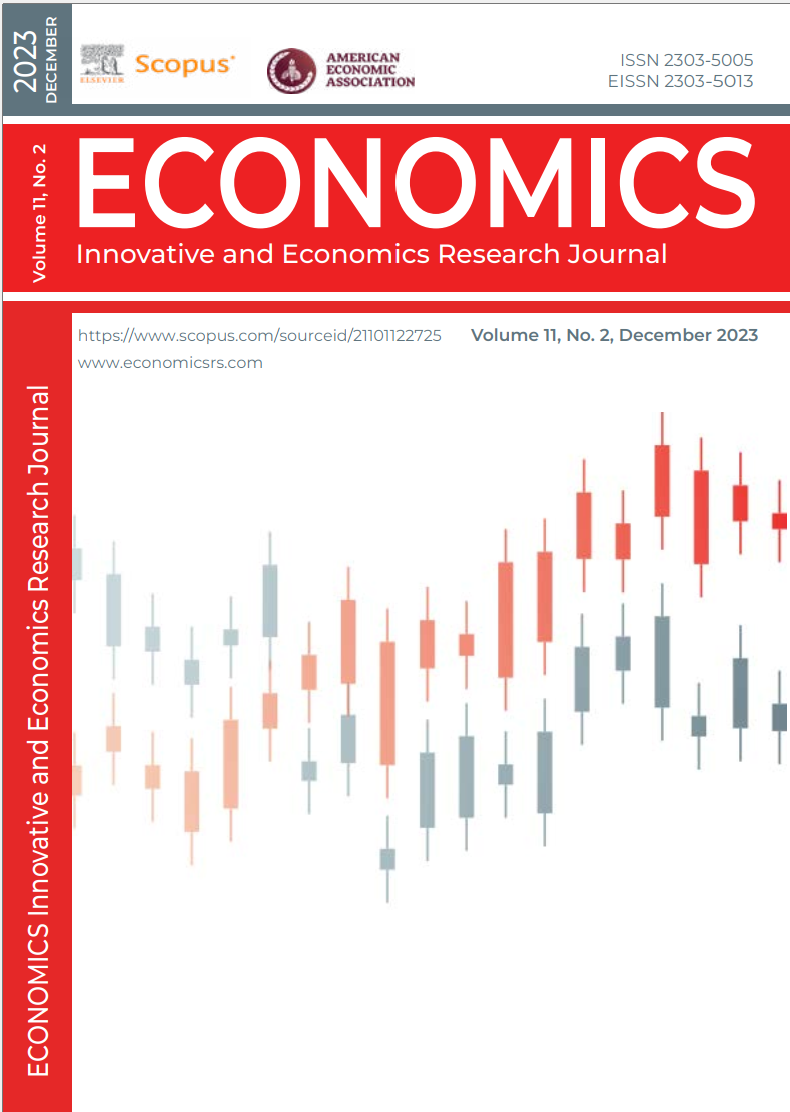ASSESSMENT OF TOURISM-LED GROWTH RISKS IN RESOURCE-RICH COUNTRIES: EVIDENCE FROM AZERBAIJAN
DOI:
https://doi.org/10.2478/eoik-2023-0053Keywords:
Azerbaijan, economic growth, tourism income, regression model, coefficient of variation, non-oil sectorAbstract
The COVID-19 pandemic has provided important lessons in determining future development strategies for countries whose economies are largely dependent on natural resources. The following study was conducted to analyze the potential for tourism to contribute to economic growth and sustainability of economic development in countries rich in natural resources during the post-resource period. Using data from the Republic of Azerbaijan, a co-integrated regression model was used in the analyses. Findings showed that (1) tourism has a positive effect on economic growth and can play a role in ensuring its sustainability; (2) a decrease in revenues from tourism carries more risk for the economy than revenues from oil (coefficient of variation); (3) if an oil and gas country chooses a tourism-based development path in the post-oil and gas era, it may face very serious challenges (due to the fact that tourism sector is highly vulnerable to direct and indirect events); (4) dominance of the tourism sector in the economy carries more risk than dominance of the oil and gas sector.
However, combining two different approaches showed that choosing tourism as one of the priority sectors in the post-oil and gas era can reduce risks and will contribute more to the diversification of the economy
References
Aktas, C. (2005). Determining the Most Appropriate Regression Equation for the Variables Affecting Turkey’s Tourism Income, Dogus Üniversitesi Dergisi, 6 (2), 163-174. https://dergipark.org.tr/tr/download/article-file/2151823
Alodadi, A., & Benhin, J. (2015). Religious Tourism and Economic Growth in Oil-Rich Countries: Evidence from Saudi Arabia. Tourism Analysis, 20 (6), 645-651. https://doi.org/10.3727/108354215X14464845877995
Albassam, B. (2015). Economic Diversification in Saudi Arabia: Myth or Reality? Resources Policy, 44, 112–117. https://doi.org/10.1016/j.resourpol.2015.02.005
Amin, S., & Taghizadeh-Hesary, F. (2023). Tourism, Sustainability, and the Economy in Bangladesh: The innovation connection amidst Covid-19. Economic Analysis and Policy, 79, 53-167. https://doi.org/10.1016/j.eap.2023.06.018
Azizov, A. (2022) Formation and Development of Entrepreneurship in the Field of Tourism of the Republic of Azerbaijan. Ganja 2022. https://aak.gov.az/upload/dissertasion/_qtisad_elml_ri/(3)Az_elml%C9%99r_dok_%C3%A7apAnar_%C6%8Fzizov-_Avtoreferat-_az_m%C9%99tn1.pdf
Azerbaijan ─ 2026. (2022). Strategy of Socio-economic Development of the Republic of Azerbaijan in 2022─2026. Baku. https://e-qanun.az/framework/50013
Balaguer, J., & Cantavella-Jordà, M. (2002). Tourism as a Long-run Economic Growth Factor: The Spanish Case. Applied Economics, 34, 877–884. https://doi.org/10.1080/00036840110058923
Bal, H., Akça, Е., & Bayraktar, M. (2016). The Contribution of Tourism to Economic Growth: A Research on the Turkey. Journal of Academıc Approaches, 7(1), 1-20. https://dergipark.org.tr/tr/download/article-file/269294
Britton, S. (1982). The Political Economy of Tourism in the Third World. Annals of Tourism Research, 9, 331–358. https://dergipark.org.tr/tr/download/article-file/269294
Brida, J., Carrera, E., & Risso, W. (2008). A Long-Run Equilibrium Demand Function: The Mexican Tourism, Tourismos: an International Multidisciplinary Journal of Tourism, 3(1), 66-82. http://www.chios.aegean.gr/tourism/journal/vol3no1.pdf
Cahyanto, I., Wiblishauser, M., Pennington-Gray, L., & Schroeder, A. (2016). The Dynamics of Travel Avoidance: The case of Ebola in the US. Tourism Management Perspectives, 20, 195–203.
https://doi.org/10.1016/j.tmp.2016.09.004
Central Bank of the Republic of Azerbaijan (CBAR), (2023). Balance of Payments Report. https://cbar.az/page-43/external-sector-statistics?language=en
Chan, F., Lim, C., McAleer, M. (2005). Modelling Multivariate International Tourism Demand And Volatility, Tourism Management, 26, 459-471. https://doi.org/10.1016/j.tourman.2004.02.013
Copeland, B. (1991). Tourism, Welfare and De-industrialization in a Small Open Economy. Ecominica, 58, 512-529. https://doi.org/10.2307/2554696
Cuhadar, M. (2020). A Comparatıve Study On Modellıng And Forecastıng Tourısm Revenues: the case of Turkey. Advances in Hospitality and Tourism Research, 8 (2), 235-255. https://dergipark.org.tr/en/download/article-file/1190938
Demiroglu, O., & Muller, D. (2021). Managing Emerging Destinations: The Case of Azerbaijan. Journal of Tourismology, 7(1), 1-27. https://doi.org/10.26650/jot.2021.7.1.0001
Diamond, J. (1977). Tourism’s Role in Economic Development: The Case Reexamined. Economic Development and Cultural Change, 25 (3), 539-553. https://www.jstor.org/stable/1152656
Dritsakis, N. (2004). Tourism as a Long-run Economic Growth Factor: An Empirical Investigation for Greece using Causality Analysis, Tourism Economics, 10, 305-316. https://doi.org/10.5367/00000000418950
Earth-changers. (2022). Worldwide, Tourism Supports 10% of all jobs: 319 million (pre-Covid). https://www.earth-changers.com/purpose/employment-livelihoods
Eugenio-Martin, M. (2004). Tourism and Economic Growth in Latin American Countries: A Panel Data Approach. Nota Dılavoro, 26. http://dx.doi.org/10.2139/ssrn.504482
Fayed, H., & Fletcher, J. (2002). Globalization of Economic Activity: Issues for Tourism. Tourism Economics, 8 (2), 207-230. https://doi.org/10.5367/000000002101298070
Hao J, Var T., & Chon, J. (2002). A Forecasting Model of Tourist Arrivals from Major Markets to Thailand. Tourism Analysis, 8 (1), 33–45. https://doi.org/10.3727/108354203108750157
Hayes, A. (2023). Co-efficient of Variation Meaning and How to Use It. Investopedia. https://www.investopedia.com/terms/c/coefficientofvariation.asp
Huseyn, A., & Museyibov, A. (2022). Development Opportunities And Recovery Strategy Of The Tourism Sector after the COVID-19 Pandemic. Tourism and Hospitality Studies - International Journal, 11(2), 9-21. http://atmu.edu.az/upload/magazine/2022/12/01//-0d27688c166988415672954956110714135.pdf
Huseyn, A., & Sadigova, U. (2021). Coronavirus Impact on Azerbaijan’s Tourism Sector and Opportunities for Developing Alternative Tourism in the Post-Pandemic Period. Tomsk State University Journal of Economics, 54, 287–297. https://vital.lib.tsu.ru/vital/access/manager/Repository/koha:000722557
Huseyn, R. (2011). The necessity of Azerbaijan’s Transition From Oil-Based Economy to Multi-Sectoral Economy and Agriculture. Bilig, 59, 147-166. https://bilig.yesevi.edu.tr/yonetim/icerik/makaleler/2511-published.pdf
Işık Maden, S., Bulgan, G., & Yıldırım, S. (2019). The Effect of Tourism Sector on Economic Growth: An Empirical Study on Turkey. Journal of Yasar University, 14/55, 215-225. https://dergipark.org.tr/tr/download/article-file/799025
Karim, Z., Alia, B., & Nabila, B. (2021). The Development of Tourism in Algeria within the Master Plan for Tourism Development SDAT2025, Economic Sciences, Management and Commercial Sciences Review, 28 (14), 324-336. https://www.asjp.cerist.dz/en/downArticle/324/14/2/173294
Khalilov, H., & Huseyn, R. (2021). Impact of Oil Revenue Spending on Income Distribution: the Case of Azerbaijan. Economic Alternatives, 4, 622-639. https://doi.org/10.37075/EA.2021.4.08
Khan, N., Hassan, A. U., Fahad, S., & Naushad, M. (2020). Factors Affecting Tourism Industry and Its Impacts on Global Economy of the World. Available at SSRN 3559353. https://doi.org/10.2139/ssrn.3559353
Knoema. (2019). Azerbaijan - Travel and Tourism Direct Contribution to GDP in Current Prices. https://knoema.com/atlas/Azerbaijan/topics/Tourism/Travel-and-Tourism-Direct-Contributionto-GDP/Travel-and-tourism-direct-contribution-to-GDP
Ljubotina, P., & Raspor, A. (2022). Recovery of Slovenian tourısm after Covıd-19 and Ukraine crısıs. ECONOMICS - Innovative and Economics Research Journal, 10(1), 55-72. https://doi.org/10.2478/eoik-2022-0003
Nikolova, M., & Pavlov, P. (2021). Interconnection and Interdependence of Key Economic Sectors - Agriculture and Tourism in the Conditions of a Pandemic Crisis. Scientific Papers Series Management, Economic Engineering in Agriculture and Rural Development, 21(4), 387-396.
https://managementjournal.usamv.ro/pdf/vol.21_4/Art44.pdf
Oh, C. (2005). The Contribution of Tourism Development to Economic Growth in the Korean Economy, Tourism Management, 26 (11), 39-44. https://doi.org/10.1016/j.tourman.2003.09.014
Ozer, M. (2021)Tourism and Economic Growth in Turkey: Fourier Approach. Cankırı Karatekin University Journal of the Faculty of Economics and Administrative Sciences, 11(1), 29-43. https://dergipark.org.tr/tr/download/article-file/1039755
Pavlov, P. (2023). An Analysis of the Socio-Economic Measures for Preserving Employment in Hotels and Restaurants During the Covid-19 Pandemic in Bulgaria. Economic Alternatives, 2, 424-439. https://doi.org/10.37075/EA.2023.2.11
Pham, T. D., Dwyer, L., Su, J.-J., & Ngo, T. (2021). COVID-19 Impacts of Inbound Tourism on Australian Economy. Annals of Tourism Research, 88. https://doi.org/10.1016/j.annals.2021.103179
Proença, S., & Soukiazi, E. (2008). Tourism as an Economic Growth Factor: a Case Study for Southern European Countries, Tourism Economics, 14 (4), 791–806. https://doi.org/10.5367/000000008786440175
Rittichainuwat, B. N., & Chakraborty, G. (2009). Perceived Travel Risks Regarding Terrorism and Disease: The case of Thailand. Tourism Management, 30(3), 410–418. https://doi.org/10.1016/j.tourman.2008.08.001
Sana, N. (2021). The Role of Tourism in Economic Growth: Empirical Evidence from Saudi Arabia, Economies 2021, 9, 117. https://doi.org/10.3390/economies9030117
Shalbuzov, N., Fikretzade, F., & Huseyn, R. (2020). The International Competitiveness of Azerbaijani fruit and vegetable products. Studies in Agricultural Economics, 122 (1), 51-55. https://doi.org/10.7896/j.1921
Tang, Chor F., & Tan, Eu Ch. (2013). How stable is the Tourism-led Growth Hypothesis in Malaysia? Evidence from disaggregated Tourism Markets. Tourism Management. Volume 37, August 2013, 52-57. https://doi.org/10.1016/j.tourman.2012.12.014
Theobald, W. (2005). Global Tourism, Elsevier Inc, Third Edition. https://perpus.univpancasila.ac.id/repository/EBUPT180143.pdf
The State Statistical Committee of the Republic of Azerbaijan (SSC). (2022). Tourism in Azerbaijan 2022. Official publication, Statistical. Baku: 2022, 100 p. https://stat.gov.az/menu/6/statistical_yearbooks/
The State Statistical Committee of the Republic of Azerbaijan (SSC). (2023a). Tourism. Retrieved 2023. https://stat.gov.az/source/tourism/?lang=en
The State Statistical Committee of the Republic of Azerbaijan (SSC). (2023b). The foreign trade of Azerbaijan. Retrieved 2023. https://stat.gov.az/source/trade/?lang=en
The Statistical, Economic and Social Research and Training Centre for Islamic Countries (SESRIC). (2022). Statistical Yearbook on OIC Member Countries 2022. https://sesricdiag.blob.core.windows.net/sesric-site-blob/files/article/828.pdf
Vanegas, M., & Croes, R. (2003). Growth, Development and Tourism in a Small Economy: Evidence from Aruba, The International Journal of Tourism Research, 5 (5), 315-330. https://doi.org/10.1002/jtr.441
Wang, C., Meng, X., Siriwardana, M., & Pham, T. (2021). The impact of COVID-19 on the Chinese Tourism Industry. Tourism Economics, 28(1). https://journals.sagepub.com/doi/epub/10.1177/13548166211041209
Wickramasinghe, K., & Naranpanawa, A. (2023). Tourism and COVID-19: An economy-wide assessment. Journal of Hospitality and Tourism Management, 55 (2023), 131–138. https://doi.org/10.1016/j.jhtm.2023.03.013
World Travel & Tourism Council (WTTC). (2021a). Travel & Tourısm Economıc Impact 2021. Global Economıc Impact & Trends 2021.
World Travel & Tourism Council (WTTC). (2021b). 2020: worst year in tourism history with 1 billion fewer international arrivals. https://www.unwto.org/news/2020-worst-year-in-tourism-history-with-1-billion-fewerinternational-arrivals
World Travel & Tourism Council(WTTC). (2023). Economic Impact Reports. https://wttc.org/research/economic-impact
World Bank. (2009). Azerbaijan - Country economic memorandum: a new silk road - export-led diversification (English). Washington, D.C. : World Bank Group. http://documents.worldbank.org/curated/en/531321468221991045/Azerbaijan-Countryeconomic-memorandum-a-new-silk-road-export-led-diversification
World Bank. (2022). Azerbaijan Country Economic Memorandum. International Bank for Reconstruction and Development/The World Bank. Washington DC 20433 https://documents1.worldbank.org/curated/en/099100009222236784/pdf/P17532606988e2056084e603c9c48ddc618.pdf
Wołowiec, T., Pavlov, K., Pavlova, O., & Zaichuk, K. (2022). Tourist Services of the Western Region of Ukraine: Rating and Analysıs. ECONOMICS - Innovative and Econimics Research Journal, 10(1), 183–198. https://doi.org/10.2478/eoik-2022-0007
Yang, H. Y., & Chen, K. H. (2009). A General Equilibrium Analysis of the Economic Impact of a Tourism Crisis: A case study of the SARS Epidemic in Taiwan. Journal of Policy Research in Tourism, Leisure and Events, 1(1), 37–60. https://doi.org/10.1080/19407960902738313
Yavuz, N. (2006). Test of the Effect of Tourism Revenues on Economic Growth in Turkey: Structural Break and Causality Analysis, Dogus Üniversitesi Dergisi, 7 (2), 162-171. https://dergipark.org.tr/tr/download/article-file/2151888
Yenişehirlioğlu, E., Taşar, I., & Bayat, T/ (2020). Tourism Revenue and Economic Growth Relation in Turkey: Evidence of Symmetrical, Asymmetrical and the Rolling Window Regressions. Journal of Economic Cooperation and Development, 41, 2, 1-16, https://jecd.sesric.org/pdf.php?file=ART20020502-2.pdf
Yıldırım, J., & Ocal, N. (2004). Tourism and Economic Growth in Turkey, Economic Approach, 15 (52-53), 131-141. https://www.ekonomikyaklasim.org/fulltext/94-1395757785.pdf?1694582451
Zenker, S., & Kock, F. (2020). The Coronavirus Pandemic – A Critical Discussion of a Tourism Research Agenda. Tourism Management, 81 (2020), 1-4. https://doi.org/10.1016/j.tourman.2020.104164
Zeng, B., Carter, R. W., & De Lacy, T. (2008). Short-term Perturbations and Tourism Effects: The case of SARS in China. Current Issues in Tourism, 8(4), 306–322. https://doi.org/10.1080/13683500508668220
Downloads
Published
How to Cite
Issue
Section
License
Copyright (c) 2023 ECONOMICS - INNOVATIVE AND ECONOMICS RESEARCH JOURNAL

This work is licensed under a Creative Commons Attribution-NonCommercial-NoDerivatives 4.0 International License.























